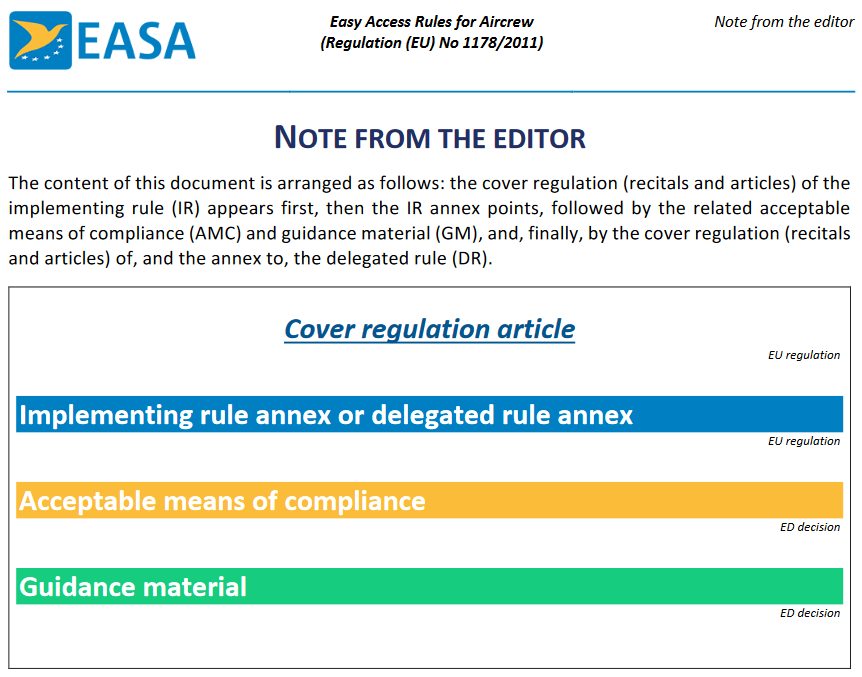EASA-Regulierungsrahmen:
Recording of flight time
Aufzeichnung von Flugzeit und Pilotenerfahrung
Es ist nicht einfach, sich im Labyrinth der EU-Gesetze zurechtzufinden, vor allem, wenn jeder Mitgliedstaat seine eigenen Ergänzungen hat.
Damit du dich in diesem Labyrinth zurechtfindest, haben wir die wichtigsten Informationen rund um dein persönliches Flugbuch zusammengefasst.
Im Folgenden werden die rechtlichen Grundlagen für die Aufzeichnung von Flugzeiten und Pilotenerfahrung im Rahmen der EASA Regulatorien erläutert, die als Goldstandard unter den Regelwerken gelten.
Diese Seite ist für Piloten gedacht, die ihre Lizenz von einem der EASA-Mitgliedstaaten ausgestellt bekommen haben.
Ebenen des EASA-Regelwerks
Die Komplexität des Luftfahrtsektors macht einen mehrstufigen Regulierungsrahmen erforderlich. Während verbindliche Vorschriften in bestimmten Situationen unverzichtbar sind, gibt es Fälle, in denen das Regulierungssystem eine gewisse Flexibilität durch nicht verbindliche Normen oder „Soft Law“ zulassen muss.
Dieser ausgewogene Ansatz ist weithin anerkannt und wird von internationalen Organisationen und nationalen Regulierungsbehörden übernommen.
Im Rahmen der EASA ist das Regulierungsmaterial in mehrere Hauptebenen gegliedert:
- Die Grundverordnung, die vom Europäischen Parlament und vom Rat angenommen wird, ist in allen ihren Aspekten verbindlich.
- Durchführungsbestimmungen (Implementing Rules) zur Grundverordnung, angenommen von der Europäischen Kommission.
- Acceptable Means of Compliance (AMC), die von der Agentur (EASA) angenommen werden.
- Certification Specifications (CS), Guidance Material (GM) und Informationen, die von der Agentur (EASA) angenommen werden.
Die Acceptable Means of Compliance (AMC) werden von der EASA mit der Prämisse angenommen, dass die Vorschriften eingehalten werden, so dass die zuständigen Behörden verpflichtet sind, beaufsichtigte Personen, die die AMC der EASA einhalten, als gesetzeskonform anzuerkennen.

Da die AMCs nicht verbindlich sind, können die beaufsichtigten Personen auf alternative Mittel zurückgreifen, um die Anforderungen der Verordnung zu erfüllen.
In den Implementing Rules wird festgelegt, dass die Umsetzung des AltMoC durch Organisationen und beaufsichtigte Personen der vorherigen Genehmigung durch die zuständige Behörde bedarf, und es wird angegeben, was zu tun ist, um die Genehmigung zu erhalten.
Damit verlieren sie jedoch die Konformitätsvermutung des EASA AMC und müssen gegenüber den zuständigen Behörden nachweisen, dass sie die Rechtsvorschriften mit anderen Instrumenten und Masnahmen einhalten.
Praktische Anwendung der Ebenen zu FCL.050 "Recording of flight time"
Der übergeordnete Regulierungsabschnitt der Europäischen Union lautet Commission Regulation (EU) No 1178/2011 (Air crew).
Recording of flight time wird durch die Implementing Rule in Annex FCL.050 geregelt (blauer Abschnitt in der Abbildung).
Die EASA hat einen Standardrahmen mit der Bezeichnung Applicable Means of Compliance (AMC1) definiert, der von den Mitgliedstaaten direkt übernommen werden kann, um die Implementing Rules zu erfüllen.
Wenn ein Mitgliedstaat nicht die AMC1 anwendet, verliert er die durch die AMC der EASA geschaffene Konformitätsvermutung und muss nachweisen, dass er das Gesetz einhält, und beschreiben, wie dies geschieht.

EASA AMC1 FCL.050 ist für die meisten EASA-Länder die etablierte „Form und Weise“.
AMC1 gilt in seiner Gesamtheit für alle EASA-Lizenzinhaber zur Einhaltung der Durchführungsvorschrift FCL.050, solange die zuständige Behörde, welche die Lizenz ausgestellt hat, nicht offiziell Alternative Means of Compliance veröffentlicht hat
Links und Referenzen
Easy Access Rules for Aircrew (Regulation (EU) No 1178/2011) including AMC1 FCL.050
Was AMC1 FCL.050 konkret besagt
AMC1 zur Regulation (EU) Nr. 1178/2011 enthält detaillierte Anleitungen zur Einhaltung der in der Verordnung festgelegten Anforderungen an die Pilotinnen und Piloten in der Zivilluftfahrt. Dieses AMC (Acceptable Means of Compliance) deckt verschiedene Aspekte ab, darunter allgemeine Anforderungen, Lizenzierung und Zertifizierung, Ausbildung, Operations und vieles mehr.
Sie enthält eine Reihe von Regeln für das persönliche Flugbuch, die zu speichernden Informationen, die Form und die rechtlichen Aspekte des Flugbuchs.
Auf der folgenden Seite sind die Anforderungen der AMC1 aufgeführt:
Anforderungen an das Flugbuch für Piloten: Allgemein und digitalHäufig gestellte Fragen
Hast du Fragen zu den Funktionen von capzlog.aero?
Frag unser Support TeamWoher weiss ich, welche rechtlichen Anforderungen für mich als Pilot relevant sind?
Dein Fluglehrer sollte dir die Grundlagen vermitteln. Du bist aber selbst dafür verantwortlich, die wichtigen Abschnitte zu kennen und sie entsprechend zu überwachen. Aber keine Sorge: capzlog.aero hilft dir, indem die richtigen Informationenan der richtigen Stelle anzeigt wird, inklusive Verweise in die Regulatorien.
Welche sind die EASA-Mitgliedstaaten?
Auf dieser Seite kann man überprüfen, ob ein Land Mitglied der EASA ist. Auf dieser EASA-Website sind die einzelnen Staaten ebenfalls aufgeführt. Die EASA-Mitgliedsstaaten sind, in alphabetischer Reihenfolge: Belgien, Bulgarien, Dänemark, Deutschland, Estland, Finnland, Frankreich, Griechenland, Irland, Island, Italien, Kroatien, Lettland, Liechtenstein, Litauen, Luxemburg, Malta, Niederlande, Norwegen, Österreich, Polen, Portugal, Rumänien, Schweden, Schweiz, Slowakei, Slowenien, Spanien, Tschechische Republik, Ungarn, Zypern.
Muss ich die gesamten Regulatorien lesen, um mein Flugbuch konform zu führen?
Es ist sicher sinnvoll, wenn du dir die Abschnitte zu den Regulatorien einmal ansiehst. Du kannst aber auch den praktischen Weg gehen und einfach diejenigen Abschnitte mal durchlesen, die du in capzlog.aero auf deiner Cockpit-Seite angezeigt bekommst.
Gibt es ein elektronisches Flugbuch der EASA?
Es gibt kein elektronisches Flugbuch, das von der EASA herausgegeben wird. capzlog.aero kommt dem aber sehr nahe, weil es die EASA-Vorschriften sehr genau umsetzt und offiziell zertifiziert ist.